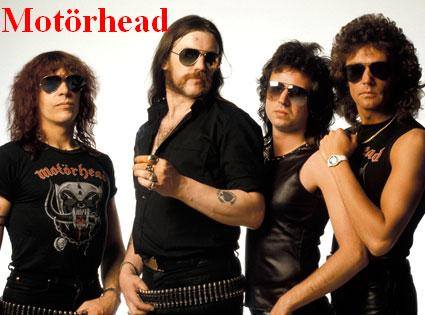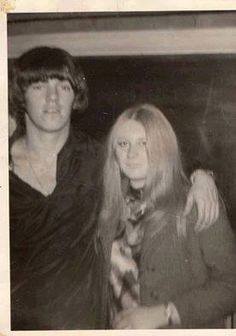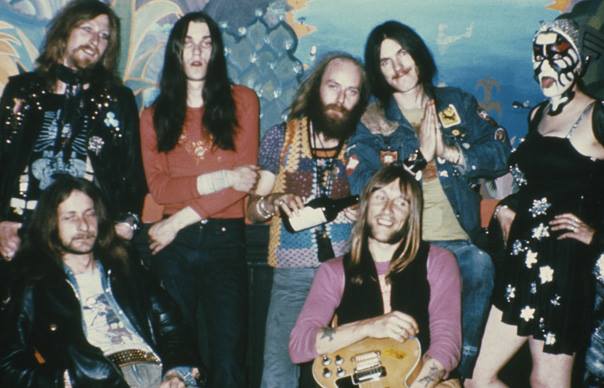December 28, 2015 Lemmy Kilmister died
DECEMBER 28, 2015 – Bassist/singer/songwriter/actor LEMMY KILMISTER (b. December 24, 1945 in Stoke-on-Trent, Staffordshire, England as Ian Fraser Kilmister) died in his home in Los Angeles, California four days after his 70th birthday from prostate cancer, congestive heart failure, and cardiac arrhythmia. Best known as the founder of Motörhead, Lemmy had lived in Los Angeles, California since 1990, most recently in a two-room apartment two blocks away from his favorite hangout, the Rainbow Bar and Grill.
Motörhead announced his death on their official Facebook page later that day. According to the band, his cancer had only been diagnosed two days prior to his deathLemmy’s manager, Todd Singerman, later revealed: “He [Lemmy] gets home [from tour], we have a big birthday party for him at the Whisky A Go Go. His friends came down and played. Two days later I could tell he wasn’t feeling good so we took him to the hospital, they release him, then after the brain scan they found the cancer in his brain and his neck … the doctor comes with the result a couple of days later and says … it’s terminal.” Lemmy’s doctor had given him between two and six months to live.
Although his manager had planned to keep the news private until his eventual death, Lemmy strongly encouraged him to make the diagnosis public in early 2016, but he died before a press release could be drafted. Following the terminal diagnosis, Rainbow Bar owner Mikael Maglieri brought a video game machine that Lemmy was fond of playing at the establishment over to his apartment so he could continue playing it from his bedside.Lemmy’s memorial service took place at Forest Lawn Memorial Park, Hollywood on January 9, 2016. The service was streamed live over YouTube with more than 230,000 people logging on to watch, while others gathered at the Rainbow.
His body was cremated following the funeral. His remains were placed in a 3D-printed mantle-piece shaped like his trademark cavalry hat and emblazoned with the slogan “born to lose, live to win”. The piece was on display during his funeral and was later interred at Forest Lawn.Lemmy was born on Christmas Eve in the Burslem area of Stoke-on-Trent, Staffordshire, England. When he was three months old, his father (who would die in 2011), an ex-Royal Air Force chaplain and concert pianist, separated from his mother. His mother and grandmother moved to nearby Newcastle-under-Lyme, then to Madeley. When Lemmy was 10, his mother married former footballer George Willis, who already had two older children from a previous marriage, Patricia and Tony, with whom Lemmy did not get along.
The family moved to a farm in the Welsh town of Benllech, Anglesey, with Lemmy later commenting that “funnily enough, being the only English kid among 700 Welsh ones didn’t make for the happiest time, but it was interesting from an anthropological point of view”. He attended Sir Thomas Jones’ School in Amlwch, where he was nicknamed “Lemmy”. It was later suggested by some that the name originated from the phrase “lemmy [lend me] a quid ’til Friday” because of his alleged habit of borrowing money from people to play slot machines, although Lemmy himself claimed that he didn’t know the origin of the name. He soon started to show an interest in rock and roll music, girls, and horses..In school, Lemmy noticed a pupil who had brought a guitar to school and had been “surrounded by chicks”.
His mother had a guitar, which he then took to school, even though he could not play, and was himself surrounded by girls. By the time he left school, his family had moved to Conwy, Wales. There, he worked at menial jobs including one in the local Hotpoint electric appliance factory, while also playing guitar for local bands such as the Sundowners and spending time at a horse-riding school. At the age of 17, Lemmy met a holidaying girl named Cathy. He followed her to Stockport, Greater Manchester, where she gave birth to his son Sean, who was put up for adoption.[5]In the 2010 documentary film “Lemmy,” he mentioned having a son whose mother has only recently “found him” and “hadn’t got the heart to tell him who his father was”, indicating that the boy – perhaps Sean – was given up for adoption.Lemmy saw the Beatles perform at the Cavern Club when he was 16, and then learned to play along on guitar to their first album “Please Please Me.”
He also admired the sarcastic attitude of the group, particularly that of John Lennon. In Stockport, Lemmy joined local bands the Rainmakers and then the Motown Sect who played northern clubs for three years. In 1965 he joined the Rockin’ Vickers who signed a deal with CBS, released three singles and toured Europe, reportedly being the first British band to visit the Socialist Federal Republic of Yugoslavia. The Rockin’ Vickers moved to Manchester, where they lived together in a flat. There Lemmy got involved with a girl named Tracy who bore him a son, Paul Inder. Lemmy did not have any involvement with him until the boy was six.Leaving the Rockin’ Vickers, Lemmy moved to London in 1967. He shared a flat with Noel Redding, bassist of the Jimi Hendrix Experience, and with Neville Chesters, their manager.
He got a job as a roadie for the band. In 1968 he joined the psychedelic rock band Sam Gopal under the name Ian Willis and recorded the album “Escalator” released in 1969.After meeting Simon King in a Chelsea shopping centre in 1969, he joined the band Opal Butterfly; but the group soon folded, having failed to raise enough interest with their singles.In August 1971 Lemmy joined the space rock band Hawkwind, who were based in Ladbroke Grove, London, as a bassist and vocalist. During his time with Hawkwind he developed an appetite for amphetamines and LSD, particularly the former. Before joining Hawkwind, he recalled Dik Mik, a former Hawkwind sound technician, visiting his squat in the middle of the night and taking speed with him. They became interested in how long “you could make the human body jump about without stopping”, which they did for a few months, until Mik ran out of money and wanted to return to Hawkwind, taking Lemmy with him.
He had no previous experience as a bass guitarist, and was cajoled into joining immediately before a benefit gig in Notting Hill by bandmate Dik Mik to have two members who enjoyed amphetamines. Lemmy quickly developed a distinctive style that was strongly shaped by his early experience as a rhythm guitarist, often using double stops and chords rather than the single note lines preferred by most bassists. His bass work was a fundamental part of the Hawkwind sound during his tenure, perhaps best documented on “Space Ritual.” He also provided the lead vocals on several songs, including the band’s biggest UK chart single, “Silver Machine”, which reached #3 in 1972.In 1975 Lemmy was arrested at the Canada/US border in Windsor, Ontario, on drug possession charges; he spent five days in jail but was released without charge. Nonetheless he was fired from Hawkwind. Afterwards, he formed a new band called Bastard with guitarist Larry Wallis (former member of the Pink Fairies, Steve Took’s Shagrat and UFO) and drummer Lucas Fox. Lemmy and Took were friends, and Took was the stepfather to Lemmy’s son Paul. When his manager informed him that a band by the name of Bastard would never get a slot on “Top of the Pops,” Lemmy changed the band’s name to “Motörhead” – the title of the last song he had written for Hawkwind.Soon after, both Wallis and Fox were replaced with guitarist “Fast” Eddie Clarke and drummer Phil “Philthy Animal” Taylor and with this line-up the band began to achieve success. Lemmy’s guttural vocals were unique in rock at that time, and were copied during the time when punk rock became popular. The band’s sound appealed to Lemmy’s original fans and, eventually, to fans of punk. Lemmy asserted that he generally felt more kinship with punks than with metalheads; he even played with the Damned for a handful of gigs when they had no regular bassist. The band’s success peaked in 1980 and 1981 with several UK chart hits, including the single “Ace of Spades”, which remained a crowd favorite throughout the band’s career, and the UK #1 live album “No Sleep ’til Hammersmith.”
Motörhead became one of the most influential bands in heavy metal. Their (and Lemmy’s) last live performance was in Berlin on December 11, 2015.Lemmy worked with several musicians, apart from his Motörhead band-mates, over the course of his career. He wrote the song “R.A.M.O.N.E.S” for the Ramones, which he played in his live sets as a tribute to the band. He was brought in as a songwriter for Ozzy Osbourne’s 1991 ‘No More Tears” album, providing lyrics for the tracks “Hellraiser,” (which Motörhead later recorded themselves and released as a single), “Desire,” “I Don’t Want to Change the World” and the single “Mama I’m Coming Home”. Lemmy noted in several magazine and television interviews that he made more money from the royalties of that one song than he had in his entire time with Motörhead.
After being diagnosed with Type 2 diabetes in 2000, for which he was hospitalised briefly, Lemmy again appeared with Motörhead at WrestleMania X-Seven. Lemmy published his autobiography, “White Line Fever,” in November 2002. In 2005 Motörhead won their first Grammy in the Best Metal Performance category with their cover of Metallica’s “Whiplash”. In the same year he began recording an unreleased solo album titled “Lemmy & Friends,” which was intended to include a collaboration with Janet Jackson.Lemmy also had many minor roles in film and television. Lemmy made appearances in film and television, including the 1990 science fiction film “Hardware” and the 1987 comedy “Eat the Rich,” for which Motörhead also recorded the soundtracks including the title song. He appeared as himself in the 1986 “The Comic Strip Presents…” episode “More Bad News,” along with fellow heavy metal musicians Ozzy Osbourne, Scorpions (band) and Def Leppard. In 1984 Motörhead were the musical guests on the TV show “The Young Ones,” in the episode “Bambi”. He appears in the 1994 comedy “Airheads” (in which he is credited as “Lemmy von Motörhead”) Lemmy has also appeared in several movies from Troma Entertainment, including the narrator in 1996’s Tromeo and Julietand as himself in both “Terror Firmer” and “Citizen Toxie: The Toxic Avenger IV.” His last role was portraying the President of the United States in “Return to Nuke ‘Em High.”Lemmy has a cameo role in the 2001 film “Down and Out with the Dolls” as a lodger who lives in a closet.
He appeared on “Down and Dirty” with Jim Norton as the series “DJ,” and also wrote the theme music. He also appeared in a 2001 advert for Kit Kat, playing violin as part of a string quartet in a genteel tearoom. The 2010 rockumentary film “Lemmy” was directed and produced by Greg Olliver and Wes Orshoski. It consists of a combination of 16 mm film and HD video footage, produced over three years. It features interviews with friends, peers, and admirers such as Dave Grohl, Slash, Ozzy Osbourne, James Hetfield, Lars Ulrich, Kirk Hammett, and Robert Trujillo ofMetallica, David Ellefson of Megadeth, Scott Ian of Anthrax, Alice Cooper, Peter Hook of Joy Division/New Order, Dee Snider,Nikki Sixx, Mick Jones of the Clash, Ice-T, Kat Von D, Henry Rollins, Lars Frederiksen of Rancid, Jim Heath of The Reverend Horton Heat, Slim Jim Phantom of the Stray Cats, Mike Inez, Joan Jett, pro skateboarder Geoff Rowley, pro wrestler Triple H,”Fast” Eddie Clarke, Jarvis Cocker, Marky Ramone, former Hawkwind bandmates Dave Brock and Stacia, and Steve Vai. In 2015 Lemmy appeared as a central figure in the Björn Tagemose-directed silent film “Gutterdämmerung” opposite Grace Jones, Henry Rollins, Iggy Pop, Tom Araya of Slayer and Eagles of Death Metal’s Jesse Hughes.Aside from his music projects and film activities, Lemmy was well known for his hard-living lifestyle and regular consumption of alcohol and amphetamines. He was also noted for his collection of Nazi memorabilia and use of Nazi symbolism, although he said he did not support Nazi ideals and was a libertarian or anarchist. He was also known for his appearance (including long hair, mutton chops and facial moles), his distinctive gravelly voice, and distinctive bass playing style. On November 17, 2016, Metallica released a tribute song titled “Murder One”, named after Lemmy’s frequently used amp. The song, from their album “Hardwired… to Self-Destruct” depicts Lemmy’s rise to fame.
SOURCES
http://www.motorheadmusic.com/
http://moonweed.free.fr/hawkwind.html
http://www.imdb.com/name/nm0501437/
http://www.hawkwindmuseum.co.uk/tix2b.htm
http://www.metal-archives.com/bands/Mot%C3%B6rhead/203
http://www.spirit-of-metal.com/groupe-groupe-Motorhead-l…
http://www.allmusic.com/…/hawkwind-mn0000672011/biography
http://www.allmusic.com/…/mot%C3%B6rhead…/biography
http://www.allmusic.com/artist/lemmy-mn0000238341/biography
https://en.wikipedia.org/wiki/Mot%C3%B6rhead







